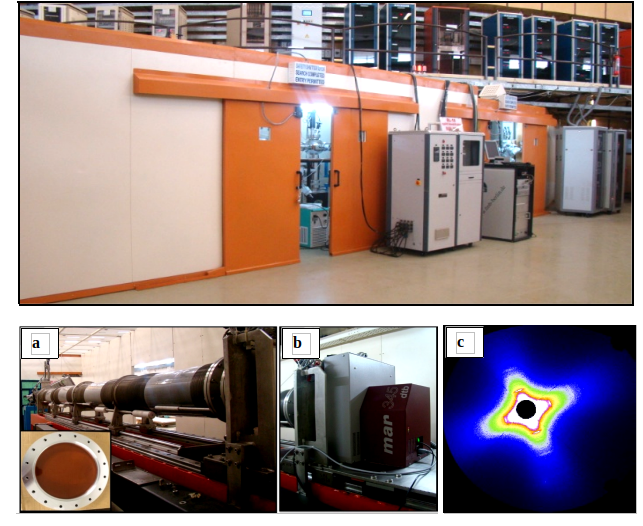

Division/Section Name
Basic research in nuclear physics spanning accelerator/reactor based fusion-fission studies, nuclear astrophysics, nuclear data management and reactor based neutrino physics. Innovating detectors and technologies for nuclear physics studies & computation along with operation, maintenance and development of heavy ion accelerators
Building, maintenance, operation and utilization of the National Facility for Neutron Beam Research (NFNBR) at Dhruva reactor for carrying out frontier research in Condensed Matter Physics (Advanced Magnetic Materials, Structure and Dynamics of Functional Materials, Soft Matter Structure and Interaction Studies, and Nano Structures and Interaction Studies)
Condensed matter research under high pressure
Development of Liquid Hydrogen Cold Neutron Source
Gamma ray Astronomy, Multiwavelength Astrophysics and Astroparticle Physics Research using MACE and TACTIC telescopes
Development of beamlines at Indus synchrotron radiation sources for facilitating in-situ studies and variations in physical properties of materials when subjected to temperature, magnetic field and pressure
Research in Atomic & Molecular Spectroscopy and Synchrotron based spectroscopy. Design & Development of Optical instruments, Multilayer Thinfilm Optical devices, Photonic & Interferometry based systems for Spectroscopic, Nuclear reactor and Synchrotron beamline applications utilizing, Lasers, X-rays and Neutron beams
To work towards the growth of applied physics domain in the areas of Crystals, Nuclear Detectors, Gas Sensors, Thermoelectrics and UHV based surface analytical instruments and to develop fixed, portable and compact high intensity neutron generators for variety of basic and applied research including fast neutron radiography, material damage studies, explosive detection and fissile material detection
Advancement of indigenous technology in niche areas of Electromagnetics, Mass-Spectrometers, RF systems, Ultra High Vacuum systems and Superconductivity. Development of unique instruments for electromagnetic, magnetic and vacuum applications. Development of gas-sensors.
Research in complex systems and quantum state engineering: physics, methods and technology. From basic research in the area of quantum computing and information science to development of quantum technology based on superconducting qubits
Development of neutron detectors such as BF3 Proportional Counters, 3He based 1-D Position Sensitive Detectors and 2-D Area Detectors
Research in select areas of theoretical Physics and applied Mathematics. Present focus includes modelling advanced electron sources having high brightness and low emittance, space-charge affected electron beams and development of indigenous particle-in-cell code PASUPAT for front-line research
The Indian Scintillator Matrix for Reactor Anti-Neutrinos – ISMRAN, is an experiment designed
for reactor antineutrino measurements for realizing the goals of reactor monitoring and studies on
active-sterile neutrino mixing to understand the Reactor Antineutrino Anamoly (RAA). ISMRAN
Phase – I (1 ton by weight in an interactive volume of 1 m3
, of Gd wrapped Plastic Scintillators,
with 200 channels of read outs via digitizers) has been currently assembled at Hall-9, BARC
(Fig.1) for measuring the cosmogenic background in a non-reactor environment, before its
scheduled shifting, with shielding, to Dhruva Reactor Hall, in January 2021.
Superconducting magnets has to be cooled to low temperature (4.2K/ -268.95oC) to achieve its superconducting (Zero DC resistance) property. Cooling of superconducting magnets can be carried out either by liquid helium or using closed cycle cryocoolers. Superconducting Magnets cooled by cryocoolers are cryogen free (do not require liquid helium) and state of art technology system used for variety of industrial applications like magnetic separation, Magnetic Resonance Imaging. Cryogen free superconducting magnets are portable and can be deployed easily for various Research and Industrial applications.
The MACE telescope is among a very few state of the art ground-based gamma-ray instruments and presently the second largest telescope worldwide. MACE is located at the highest altitude (4270 m above sea level) compared to existing gamma ray telescopes. The installation of MACE was completed in December 2019.
This invention describes a novel and the most versatile phoswich radiation detector consisting of two single crystals scintillators. It can detect and discriminate various types of radiations like alpha, neutrons, gamma simultaneously having versatile applications in academic, nuclear, security and medical fields. The detector has the highest figure of merit of discriminitation ability that is improved more than 100% when these single crystal scintillators are used separately
The beamline provides quantitative mesoscopic structural information (1-100 nm) from a wide variety of condensed matter systems, including nanoparticles, soft matter, alloys, ceramics, porous materials, etc. This beamline aims to probe time dependent phenomena in such materials.
The neutron time of flight spectrometer at Dhruva reactor is employed for inelastic neutron scattering experiments to determine the phonon density of states of materials.
An array of indigenously developed forty 3He filled one metre long position sensitive detectors provides horizontal coverage of 40o to 114o. The detector signal is stored in an indigenous multichannel time recording unit which is started synchronously with each pulse from the neutron Fermi chopper.
A facility to grow the oxide single crystals using an optical floating zone technique employing four halogen lamps and ellipsoidal mirrors has been set up at Solid State Physics Division, BARC, Mumbai.
In the optical floating zone furnace , ellipsoidal mirrors are used to focus light from halogen bulbs to a point inside a quartz tube. Heat causes a target material to melt, which is then cooled in a controlled manner to result in a single crystal. The furnace is well suited to grow large single crystals of transition metal oxides. In addition, x-ray Laue diffraction facility has also been set up for characterizing the grown single crystals. Large‐size single‐crystals of LiCoO2 (cathode material for lithium-ion battery) have been successfully grown using the installed optical floating zone furnace.

he beamline provides quantitative mesoscopic structural information (1-100 nm) from a wide variety of condensed matter systems, including nanoparticles, soft matter, alloys, ceramics, porous materials, etc. This beamline aims to probe time dependent phenomena in such materials.

The MACE telescope is among a very few state of the art ground-based gamma-ray instruments and presently the second largest telescope worldwide. MACE is located at the highest altitude (4270 m above sea level) compared to existing gamma ray telescopes. The installation of MACE was completed in December 2019.